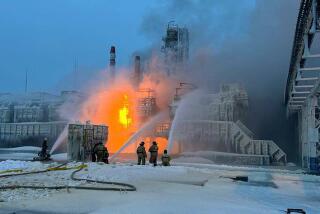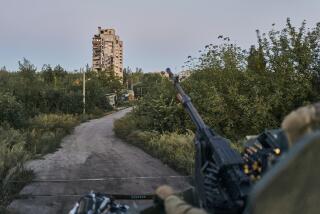Marines, Afghan troops seek to secure their hold on Marja
- Share via
Reporting from outside Marja and Kabul, Afghanistan — Insurgent holdouts in the town of Marja on Sunday aimed sporadic but sometimes intense fire at U.S. Marines and Afghan troops seeking to solidify their hold on the southern Afghan town.
NATO also reported its forces had accidentally killed 12 Afghan civilians in a misdirected rocket strike in Nad Ali, the district in which Marja lies -- the first major episode of civilian casualties since the start of the offensive on Saturday. The alliance expressed deep regret and said it was immediately suspending use of the weapons system involved.
Afghan officials said 27 insurgents had been killed so far in the fighting in Helmand province, long a heartland of the insurgency. NATO reported the death of Western service member in an explosion Sunday in southern Afghanistan, but did not disclose the nationality involved, or say whether the fatality came in the course of the assault on Marja.
The offensive, among the largest since the start of the Afghan war in 2001, is the first major military confrontation since the start of a 30,000-strong U.S. troop buildup ordered late last year by President Obama. In coming months, the town will also be a crucial test case of Afghans’ ability, with NATO’s help, to maintain order and governance in areas that the coalition succeeds in clearing of Taliban.
On the second full day of fighting, the Taliban and other insurgent foot soldiers remained a shadowy enemy: Western commanders still do not have a solid estimate of how many militants remain in the farming town and its environs, which for years had served as a Taliban sanctuary.
Estimates before the coalition assault that began early Saturday ranged from 400 to around 1,000 Taliban and other fighters in the town, with perhaps 150 of those considered “hardcore” militants who would fight to the death rather than slip away. Those are thought to include some Chechen and Uzbek fighters with likely links to Al Qaeda.
Some Taliban fled before the battle. The Marines had widely publicized their plans to take the town, in hopes of driving off less committed fighters and thus avoiding heavy close-quarters combat that could end up harming civilians.
In line with their usual practice, insurgents avoided massing for a confrontation, instead staging hit-and-run attacks. Even the Marines’ commander, Brig. Gen. Larry Nicholson, had to duck sniper fire Sunday as he was visiting a front-line Marine position, the Associated Press reported.
For the advancing Marines, it was a rough, dirty slog -- and a slow one. Companies of U.S. and Afghan troops moved through the streets, carefully detonating improvised explosive devices, or IEDs, in their path. Plumes of dusty smoke arose from the blast sites.
Commanders acknowledge that such “clearing” could go on for days or weeks. The town and its outskirts are thickly sown with homemade bombs, which are the insurgents’ weapon of choice against much better armed coalition troops.
Advancing forces have uncovered some major caches of bomb-making components, including detonation cords and hundreds of pounds of ammonium nitrate, an agricultural chemical recently banned by Afghan authorities because it was being so widely used as an ingredient in IEDs.
In Marja’s center, vanguard coalition forces laid claim to more key sites, including some strategically located walled compounds. Marines guarding one such makeshift outpost came under insurgent fire when Afghan troops inside the compound raised their national flag, the Reuters news agency reported.
A total of about 15,000 U.S., British, Afghan and other coalition troops -- some combat units, some providing support -- are taking part in the offensive, about half of them deployed and around Marja itself. NATO also plans to secure the sprawling district surrounding the town to make it harder for the Taliban to regain a foothold in the area.
tony.perry@latimes.com laura.king@latimes.com
More to Read
Sign up for Essential California
The most important California stories and recommendations in your inbox every morning.
You may occasionally receive promotional content from the Los Angeles Times.










